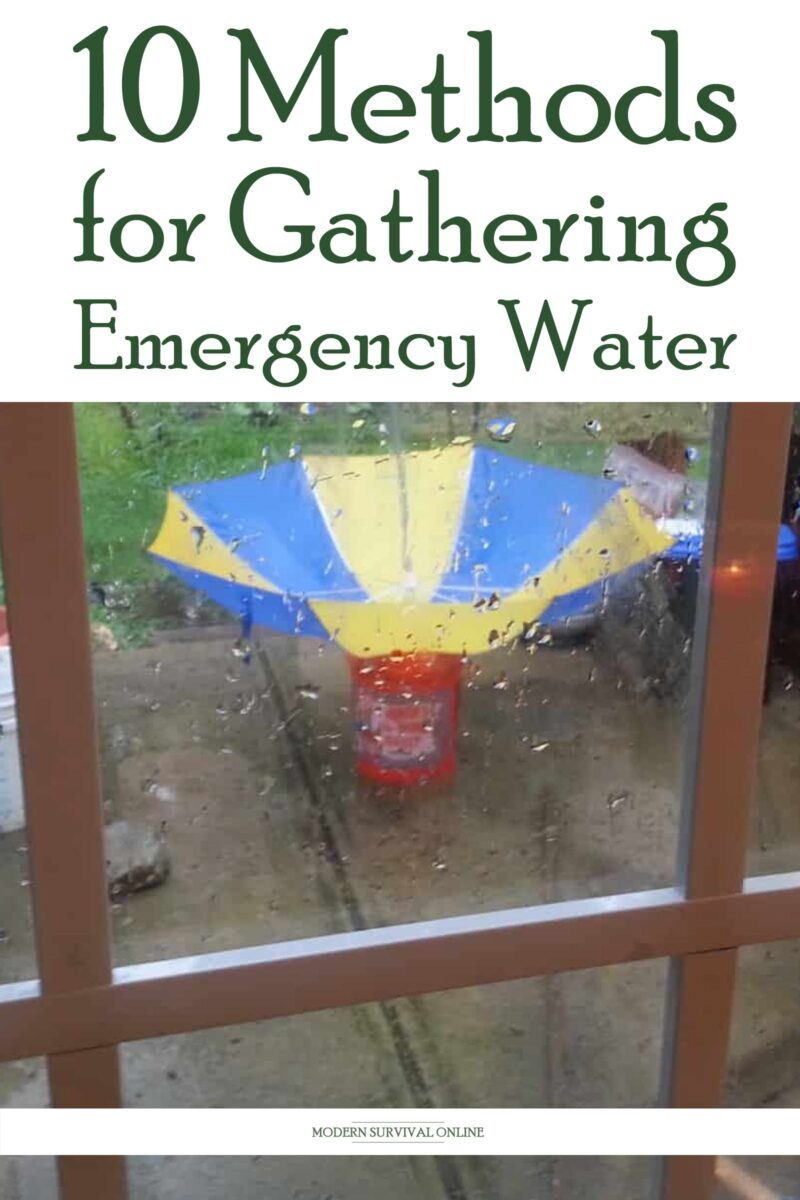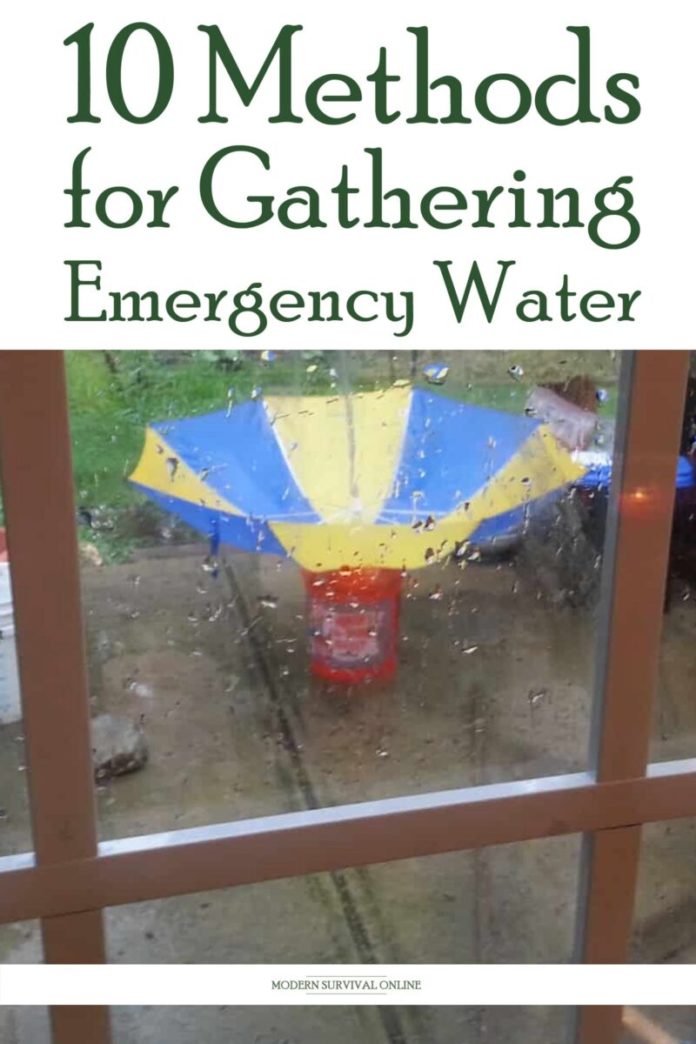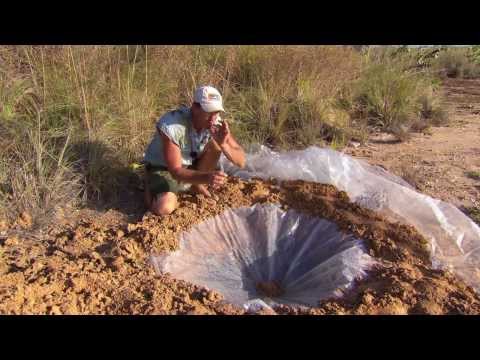Hardly anyone that has any amount of prepping experience needs to be told now how important water is in a survival situation. Water is absolutely critical to survival, and a few days without enough water can easily kill or incapacitate. This is one of those survival necessities that just won’t wait.
However, the need for water is easily understood but the logistics of acquiring and storing emergency water during a short or long-term SHTF scenario are another thing entirely.
Sure, it is easy to say that one should simply stock up on bottled water or purified water by the gallon, but that doesn’t cover all of our bases.
A well-rounded water procurement plan is an essential component for any properly developed SHTF response.
In order to help you gather from emergency water sources we are bringing you a list of 10 proven methods that you can employ pretty much anywhere that water can be found in order to supplement your own stocks.
Bottled Water Isn’t Enough
I must impress upon you that having a stash of bottled water, no matter how big, is just not enough.
Why preppers fall into the trap of believing that purchased, purified water can solve all of their logistical needs when it comes to H2O, I can’t say.
Maybe they’d rather throw money at a problem instead of developing skills, or they feel like they are just not up to the task.
This is understandable, but misguided. That bottled water will eventually run out, and is likely to run out a lot quicker than you are counting on.
When you consider that you’ll need water not just for drinking, but also some for cooking and then more for hygiene even the largest stockpile of the prepackaged stuff can evaporate faster than you’d like.
The solution, of course, is to make use of renewable or incidental sources of water to supplement or replace your supply of bottled water.
Going all in on one without the other is like knowing how to drive a car without knowing how to change a tire. It is a fundamental vulnerability that will, absolutely will, bite you in the rear given time.
Don’t let that happen to you. The following methods will arm you with everything you need to ensure your own supply of water stays intact.
10 Methods for Gathering Emergency Water
Buckets and Other Containers
Buckets and other containers are one of the best tried and true methods for gathering emergency water, particularly when you have short notice, a quickly developing situation and imminent or ongoing rainfall.
All you need to do is place your buckets and any other container that is reasonably clean outside with a clear view of open sky and they will gather nominally clean and drinkable water with no extra input on your part.
Now, the logistics of this can get tricky depending on your situation. Obviously if you have more containers you have a greater capacity and a greater surface area for catching what rain does fall.
But you’ll have to move those containers and either bring them inside or empty them into a centralized storage vessel for holding and dispensing the water later.
In a pinch, you can leave the water in those containers and cover it to keep bugs, dust and other debris out.
One of the best and cheapest, adaptable rain catching plans is a little more than a collection of 5 gallon buckets with heavy, gasket sealing lids put away for a literal rainy day.
They hold plenty of water and are reasonably easy to move even when full, and plenty durable enough for the job. However, there are ways to improve this basic method, and we’ll get into that below.
Umbrella
In a literal and figurative inversion of what you typically employ an umbrella for, umbrellas make handy and enhancements for gathering rainwater using the bucket and container method described above.
All you need to do is open the umbrella and invert it before placing it atop the bucket to rest:

In essence, this transforms the umbrella into a larger surface area it can gather more water per hour and also directs it into your container a lot like a funnel.
Depending on the design of your umbrella you might need to poke a hole at the top where the stem joins the center of the canopy in order to allow the rain water to drain effectively into your container.
Note that you don’t need a particularly high quality umbrella in order to implement this technique.
You might want to gather a few cheapy department store or dollar store umbrellas to go along with your buckets as discussed above for a dirt cheap and highly effective rain catching system.
Whole House Rain Catcher System
Probably the Cadillac of emergency water collection systems, a whole house rain catching system is one that is built into the gutters of a home or other structure.
By utilizing the enormous surface area of the roof and the efficient direction and collection system of gutters and downspouts, enormous quantities of rainwater can be collected in a very short duration and then routed into a variety of storage solutions.
One of the most common collection vessels is a simple rain barrel but above or below ground tanks, sometimes connected in series to prevent overflow and provide the maximum amount of water captured are also popular.
These systems also often make use of diverters and other specialty hardware for directing the water to where it needs to go, according to the mandates of the gravity fed system, of course!
Probably the best part of these systems for our purposes is that they require no major interaction on the part of the homeowner once they are installed and set up correctly.
These are also entirely within the realm of a weekend or week-long DIY job for those who are interested, and rudimentary versions can be done in as little as a couple of hours assuming you have the container and a few other parts on hand.
Improvised Rain Catcher
For some folks, buckets and other containers are going to be inefficient but a whole house rain catcher system is either not viable financially or for other reasons. When it maximum return on investment must be obtained, an improvised rain catching system is called for.
These systems take many forms, but most of them rely on the use of heavy duty plastic sheeting and some other extra large container for water storage, anything from a clean or cleaned trough to a repurposed kiddie pool or something else.
By hanging up the plastic using any convenient object or erecting a simple scaffold an extra large surface area can be crafted to rapidly and efficiently direct rainfall.
Even a wide, low-lying area that is only a few inches deep can hold a vast, meaningful amount of rainfall if care is given to properly setting up and securing the edges of the plastic wrap.
This is another highly adaptable and affordable rain catching setup that can be employed almost anywhere to good effect and is an indispensable part of your prepping toolbox.
Melt Ice or Snow
for those who live in colder climates where it rarely if ever rains, or during the cold months, melting ice and snow is a viable method for gathering water suitable for drinking and cooking that might need minimal filtration, if any.
to accomplish this, it might be as simple as gathering the ice or snow in containers as above and bring it inside to melt, or speeding up the process by placing it near a fire or some other heating appliance.
Whatever the case, if the snow or ice is collected directly from the sky it is more or less safe to drink immediately, but if you gather it from the ground or some other surface you might need to filter it the same as anything else.
It should go without saying that collecting snow or ice that is obviously discolored, dirty, slushy or formed on a dirty surface means it is going to be more contaminated then the pure white stuff.
Nonetheless, this might be the primary means of gathering emergency water in many of the colder climates around the world.
Collect from River, Lake, Stream, etc.
One of the tried and true methods for gathering emergency water is simply to go collect it from a nearby river, lake, stream, pond or other large body of water, potentially even including man-made sources like pools.
You can collect this water however you will, either using buckets and other containers or directly filling your personal hydration vessels as you would during any other movement or exercise in the field.
However, compared to collecting rainwater, drawing water from natural ground sources, even those that appear fresh and sparkling clean, means you’re going to have to filter the water to remove contaminants, both dissolved solids and harmful microbes.
Failure to do this means you’ll be running a fairly substantial risk of contracting a nasty stomach bug that could see you curled up and leaking from both ends if you catch my drift.
Dehydration and electrolyte loss can prove to be the final nail in the coffin in this case if it occurs during a time sensitive life or death situation.
For fathering water from low-lying or otherwise difficult to access natural sources consider using a siphon or hand pump and transferring it into a larger container
Drain the Water Heater
Believe it or not, you might not even have to leave your home to access a usable reserve of emergency water.
Any home that has a hot water heater has dozens of gallons on tap, literally, and with a little bit of ingenuity and know how you can access this water for drinking and other tasks.
All you need to do to drain the water from your water heater is to follow the manufacturer’s instructions for doing so, typically consisting of opening a valve or vent near the top and then draining the contents of the water heater through a spigot near the bottom.
Note that many water heaters have standard, threaded hookups for hoses that may well provide you better control and direction for this water.
Trust me; you don’t want to flood your house in the process as you already have enough to deal with if you are doing this!
Now, it is worth noting that this water is the same as the water that comes out of your tap for all intents and purposes, but the inside of the water heater can be rusty or heavily contaminated with mineral buildup, potentially giving the water an off taste. That being said, you can do a heck of a lot worse than this for emergency drinking water.
Fill a Bathtub Basin
One of the best ways to quickly gather emergency drinking water, particularly immediately prior to the onset of an event or in the immediate aftermath of one where our water supply systems have not been compromised is through the use of a bathtub basin bag.
These ingenious devices are a great option for preppers, and consist of a large and heavy duty mylar or rubber bag that stows into a compact, folded form until it is needed.
Once you open it and deploy it in your tub a large and easy to fill neck can be placed under the faucet in your tub before opening the tap.
And as little time as it takes you to fill up your bathtub you can have dozens of gallons of fresh water in a clean and sealed container ready to use for all sorts of things.
These are a particularly good option for people who live in apartments or other build up areas since reliably setting up a rain catching system might be difficult or impossible under the circumstances.
A bathtub basin obviously precludes you from using your tub for other things while it is full, but this is a small price to pay for sizable, on demand water storage.
Check Pipes and Hoses
Another great option for urban and suburban preppers who need to gather emergency fresh water is to check for existing water in pipes and hoses around your home and potentially others.
Just because you turn off a tap and water stops flowing does not mean that there is no water remaining in the pipe or hose connected to the faucet.
A clever prepper can take advantage of some simple principles to access this water, and though it might not seem like much under the circumstances when it is repeated a handful of times you can collect a fairly sizable quantity quickly and reliably, and better yet, it will be far safer and ready to drink than most other natural sources.
To access water trapped in a hose, all one has to do is disconnect the hose and then it carefully unravel it with one open end placed in a bucket or other container. An end over end motion ensures that water will drain towards the lowest point in the hose. Accessing water trapped in household and other building pipes is somewhat more involved but still simple.
First, open the uppermost faucets and taps in the structure as this will allow air into the system, somewhat pressurizing the water that resides lower in the building and it trapped in the pipes.
Then, head to the lowest faucets in the structure and position your container beneath ready to receive. Open the taps and you should have a small stream of water come out, even if the building has lost water supply.
Use a Solar Still
A solar still is an ingenious method of gathering incredibly pure water, but it comes at the price of low yield and a long operating time to produce anything more than a sip.
A solar still works by placing a transparent covering, typically plastic, over a shallow depression dug in the soil. The plastic is sealed around its edges by a line of stones or by covering them with loose earth.
Beneath the plastic a cup or other small container should be placed in the middle of the depression beneath the center of the plastic, the ladder being weighed down with a small pebble or other weight.
As the sun illuminates the solar still, moisture in the soil converts to steam before condensing on the underside of the plastic, running down to the depressed center and then dripping into the cup.
Water collected in this way, assuming the container is clean, is incredibly pure and safe to drink immediately, something that few other collection methodologies can boast.
Watch this video on YouTube
This method lends itself to small and large-scale operation, and is even easy enough to improvise while in the field, though as mentioned you’ll have to give it plenty of time to work or set up multiple stills if you want to generate water quickly.
Ready to Practice Water Collection?
Water is an undeniably essential survival prep, but chances are you won’t be able to depend on your bottled water supply alone, especially during a long-term survival scenario.
Knowing where you can get alternate sources of water, and how to gather and store them, is an important skill set for all preppers.
Review the list of procedures above and you’ll be ready for beefing up your hydration logistics chain when things get bad.




